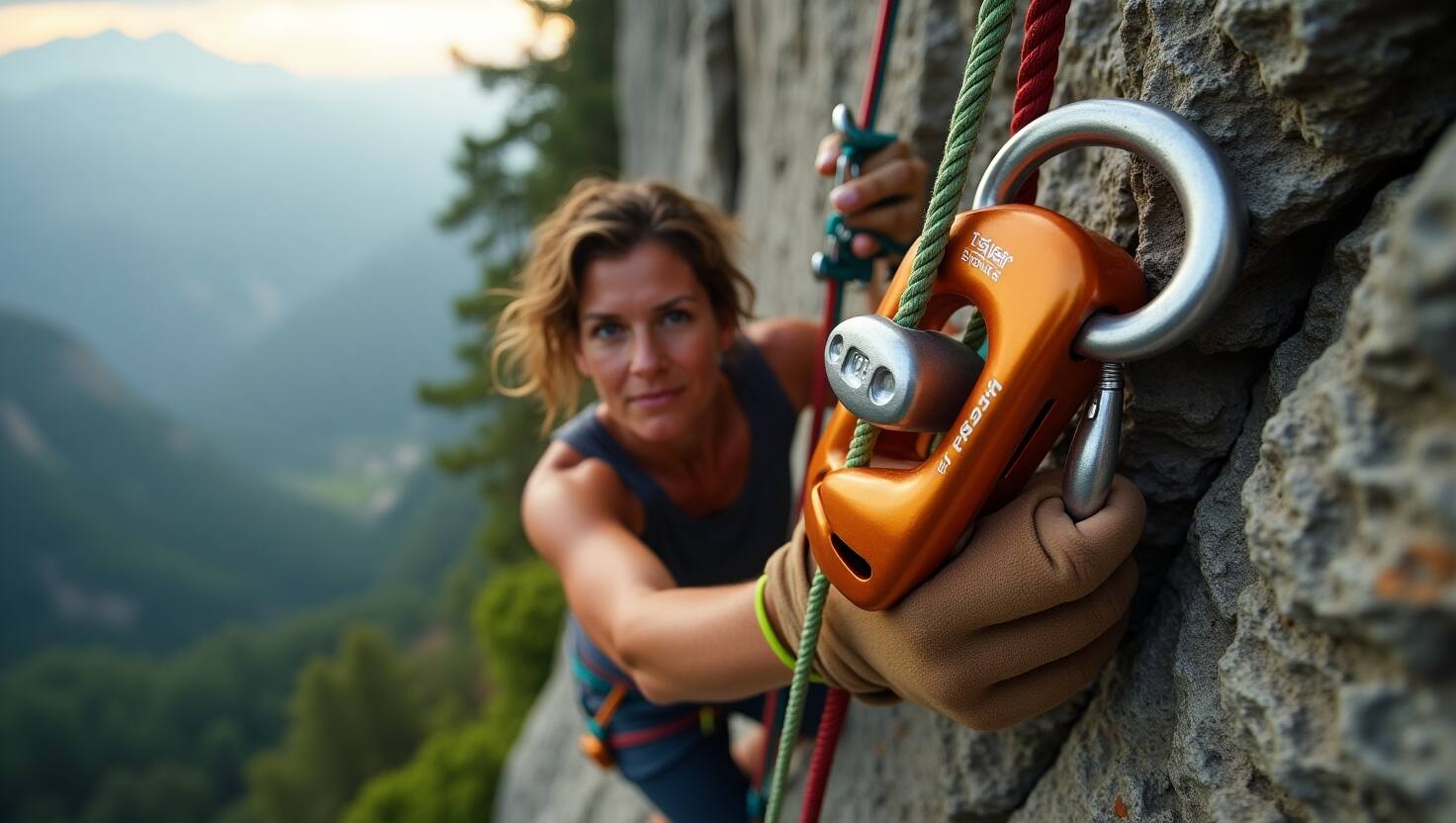Imagine this: a climber, mid-route, slips unexpectedly. The belayer, using a Petzl Grigri, catches the fall flawlessly, preventing a disaster. But rewind to a real-life scare—pro climber Ashima Shiraishi was nearly dropped when her belayer mishandled a Grigri, holding its cam and disabling the brake.
This stark contrast underscores a vital truth: the Grigri, a game-changer for lead climbing, demands proper technique to shine.
For beginners eyeing lead climbing, the Petzl Grigri offers unmatched safety and ease, making it a go-to assisted-braking belay device. But without clear guidance, it’s easy to fumble. This step-by-step guide demystifies how to use a Grigri for lead climbing, covering setup, belaying skills, and safety essentials. Whether you’re transitioning from top-rope or starting fresh, you’ll gain the confidence to belay like a pro. Let’s dive in!
Understanding the Petzl Grigri: Your Key to Safe Lead Climbing
The Petzl Grigri, launched in 1991, revolutionized belaying with its assisted-braking mechanism. Unlike traditional tube-style devices like the ATC, the Grigri uses a cam that pinches the rope during a fall, reducing the effort needed to hold a climber. Today, roughly 70% of belayers at climbing crags and gyms rely on Grigris, a testament to its popularity (Climbing Magazine, 2023).
Why choose a Grigri for lead climbing? Here’s why it’s a beginner’s ally:
- Enhanced Safety: The assisted-braking feature helps catch falls, even if the belayer’s grip slips momentarily.
- Ease of Use: Simplifies catching and lowering, ideal for those new to lead climbing.
- Versatility: Works for both lead and top-rope, with ropes from 8.5 to 11 mm.
But a crucial caveat: the Grigri isn’t auto-locking. You must always control the brake strand to prevent accidents. Compared to an ATC, the Grigri’s 6.3-ounce weight is slightly heavier, but its safety edge makes it worth it for novices (Outdoor Gear Lab, 2024).
Setting Up Your Grigri for Lead Climbing: Gear and Preparation
Before belaying, proper setup ensures your Grigri performs reliably. A 2017 Austrian Alpine Club study found that 85% of belaying accidents stem from technique or setup errors, not device failure. Here’s what you need and how to prepare:
Essential Gear
- Petzl Grigri: Compatible with single dynamic ropes (8.5–11 mm), covering 90% of standard climbing ropes (Petzl, 2024).
- Locking Carabiner: Use an HMS-style carabiner for smooth rope movement.
- Climbing Harness: Ensure it has a secure belay loop.
Pre-Climb Checks
- Inspect the Grigri: Check the cam, springs, and body for wear or damage.
- Verify Rope Compatibility: Confirm the rope’s diameter matches the Grigri’s range.
- Lock the Carabiner: Ensure it’s clipped to the belay loop and locked tightly.
- Partner Check: Have the climber double-check your setup to catch errors.
A solid setup minimizes risks and builds trust between you and your climbing partner.
How to Belay with a Grigri: 7 Easy Steps for Beginners
Belaying with a Grigri for lead climbing is straightforward once you master the steps. Below is a clear, seven-step process to get you started, backed by Petzl’s expert techniques and real-world insights from VDiff Climbing.
- Thread the Rope Correctly
- Follow the Grigri’s engraved diagram, ensuring the rope aligns with “climber” (going to the climber) and “brake” (your hand) labels.
- Tip: Pull the rope through to confirm smooth movement; a misthreaded rope won’t lock properly.
- Attach to Belay Loop
- Clip the Grigri to a locked HMS carabiner on your harness’s belay loop.
- Check: Ensure the Grigri’s handle faces outward for easy access.
- Perform a Partner Check
- Ask the climber to verify rope threading, carabiner lock, and harness connections.
- Stat: Partner checks reduce setup errors by 60% (Climbing Magazine, 2022).
- Use the PBUS Technique for Slow Slack
- Master the Pull-Brake-Under-Slide (PBUS) method: Pull rope with one hand, brake with the other, slide the brake hand back, repeat.
- Why? PBUS ensures controlled slack, preventing short-roping (tugging the climber off balance).
- Feed Slack Quickly (Gas Mechanism Method)
- For fast clipping, press the cam with your thumb and index finger while gripping the brake strand with three fingers.
- Caution: Never release the brake strand, as this disables the cam.
- Catch a Fall Safely
- If the climber falls, pull the brake strand downward to engage the cam.
- Petzl’s tests show the Grigri adds minimal force (under 2 kN) to gear in low fall-factor scenarios (0.3), ensuring safe catches.
- Lower the Climber Smoothly
- Pull the handle gently to release tension, keeping your brake hand firm to control descent speed.
- Tip: Practice lowering in a gym to avoid jerky or rapid descents.
These steps, honed with practice, make belaying intuitive and safe. For visuals, check Petzl’s “How to Belay the Leader with a GRIGRI” video, a gold standard for beginners.
5 Common Grigri Mistakes Beginners Make in Lead Climbing
Even with a reliable device like the Grigri, beginners can stumble. Here are five pitfalls to dodge, drawn from Oliunid’s insights and r/climbing discussions:
- Holding the Cam Down
- Mistake: Pinching the cam while feeding slack disables the brake, as seen in Ashima Shiraishi’s near-drop.
- Fix: Use the gas mechanism method, keeping three fingers on the brake strand.
- Incorrect Rope Threading
- Mistake: Threading the rope backward prevents locking.
- Fix: Follow the Grigri’s diagram and double-check with your partner.
- Short-Roping the Climber
- Mistake: Feeding slack too slowly tugs the climber, disrupting their flow.
- Fix: Practice PBUS and gas mechanism techniques for smooth slack management.
- Overreliance on Assisted-Braking
- Mistake: Assuming the Grigri locks automatically leads to lax brake-strand control.
- Fix: Always grip the brake strand, as it’s your primary safety line.
- Poor Communication
- Mistake: Misunderstanding commands like “Slack!” or “Take!” causes slack issues.
- Fix: Agree on clear verbal cues before climbing.
Avoiding these errors keeps your climber safe and builds your belaying confidence.
Lead Climbing Safety Tips: Maximizing Your Grigri’s Potential
Safety is paramount in lead climbing, and the Grigri’s assisted-braking feature is only as good as your technique. Here are essential tips to ensure a secure climb, backed by Petzl and the Austrian Alpine Club:
- Always Hold the Brake Strand: The Grigri isn’t hands-free; 85% of belay accidents result from technique errors (Austrian Alpine Club, 2017).
- Practice in a Gym First: Controlled settings help you master PBUS and fall-catching before tackling outdoor crags.
- Use Clear Commands: Coordinate with your climber using calls like “Clipping!” or “Falling!” to stay in sync.
- Inspect Regularly: Check the Grigri’s cam and springs for wear to maintain reliability.
- Minimize High Fall Factors: Falls with a factor above 0.7 increase gear force by up to 2 kN, risking anchor stress (Petzl, 2024).
These habits ensure your Grigri performs at its best, keeping you and your partner safe.
Lessons Learned: Real-Life Grigri Stories for Beginners
Real-world stories drive home the importance of proper Grigri use. Here are two cautionary tales:
- Ashima Shiraishi’s Close Call (99Boulders, 2018): A belayer held the Grigri’s cam while feeding slack, disabling the brake and nearly dropping the pro climber. Lesson: Never override the cam without gripping the brake strand.
- Mojo Gear Confessional (2017): A climber tested a belayer’s bad habit of pinching the brake lever, revealing that the Grigri failed to lock when mishandled. Lesson: Stick to Petzl’s recommended techniques to avoid risks.
Takeaway: The Grigri is a powerful tool, but only proper training and vigilance prevent accidents. Practice diligently to make safety second nature.
Get Started with Confidence: Your Grigri Lead Climbing Journey
Mastering the Petzl Grigri for lead climbing opens a thrilling world of vertical adventure. By following these seven steps—threading correctly, using PBUS, catching falls, and lowering smoothly—you’ll belay with confidence. Avoid common mistakes like short-roping or cam-holding, and prioritize safety with partner checks and clear communication. Real-life stories remind us: technique trumps gear every time.
Ready to start? Practice in a gym, consult certified instructors, and dive into Petzl’s resources for deeper insights. Share this guide with your climbing crew to spark discussions, and join Reddit’s r/climbing community to swap tips. Your lead climbing journey begins here—grab your Grigri and climb on!




